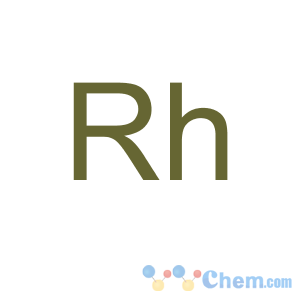Title: Rhodium
CAS Registry Number: 7440-16-6
Literature References: Rh; at. wt 102.90550; at. no. 45; valences 1-6; most common states 1, 3. Group VIII (9). One naturally occurring isotope: 103; artificial radioactive isotopes: 97-102; 104-110. Member of platinum group of metals. One of the rarest elements: constitutes about 1 ′ 10-7% of the earth's crust; found in small quantities associated with all native platinum; in the minerals rhodite, sperrylite, iridosmine; in some nickel-copper ores. Discovered in 1803 by Wollaston,
Philos. Trans. R. Soc. London 94, 419 (1804). Prepn: Vauquelin, etc., cited by Mellor,
A Comprehensive Treatise on Inorganic and Theoretical Chemistry 15, 546 (1936). Practical methods of separation: Wichers, Gilchrist,
Trans. Am. Inst. Min. Metall. Eng. 76, 619 (1928). Reviews of prepn, properties and chemistry of rhodium and other platinum metals: Gilchrist,
Chem. Rev. 32, 277-372 (1943); Beamish
et al., in
Rare Metals Handbook, C. A. Hampel, Ed. (Reinhold, New York, 1956) pp 291-328; W. P. Griffith,
The Chemistry of the Rarer Platinum Metals (John Wiley, New York, 1967) pp 1-41, 313-430; Livingstone in
Comprehensive Inorganic Chemistry Vol. 3, J. C. Bailar Jr.
et al., Eds. (Pergamon Press, Oxford, 1973) pp 1163-1189, 1233-1253.
Properties: Silvery-white, soft, ductile, malleable metal; face-centered cubic structure. mp 1966°: Roeser, Wensel,
Natl. Bur. Stand. J. Res. 12, 519 (1934); d20 12.41. Electr resistivity (0°) 4.51 m-ohms-cm. Brinell hardness: 100. Not attacked by acids even aqua regia when in compact form; the finely divided metal reacts with aqua regia. Absorbs oxygen when melted; at a red heat is slowly oxidized to the sesquioxide. Converted to the trihalide by chlorine or bromine at a red heat; not attacked by fluorine.
Melting point: mp 1966°: Roeser, Wensel,
Natl. Bur. Stand. J. Res. 12, 519 (1934)
Density: d20 12.41
CAUTION: Potential symptom of overexposure to metal fumes and insoluble compds is respiratory sensitization. Potential symptoms of overexposure to soluble compds in exptl animals are eye irritation, CNS damage.
See NIOSH Pocket Guide to Chemical Hazards (DHHS/NIOSH 97-140, 1997) p 272-275.
Use: As an alloy with platinum; as a corrosion-resistant electroplate for protecting silverware from tarnishing; for making high-reflectivity mirrors for cinema projectors, searchlights. Spongy or black rhodium is used as a catalyst in various organic hydrogenation and oxidation reactions.

